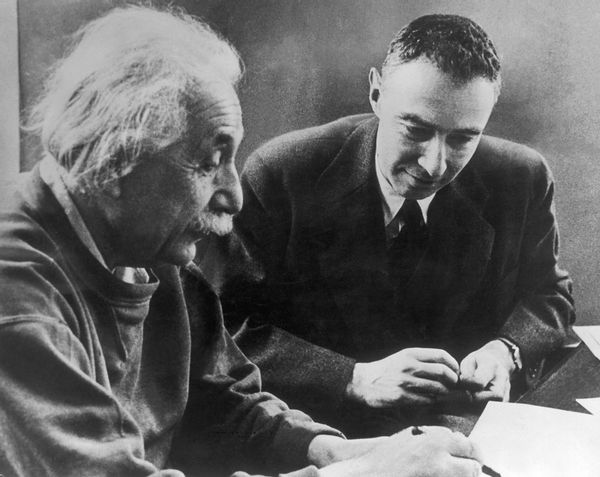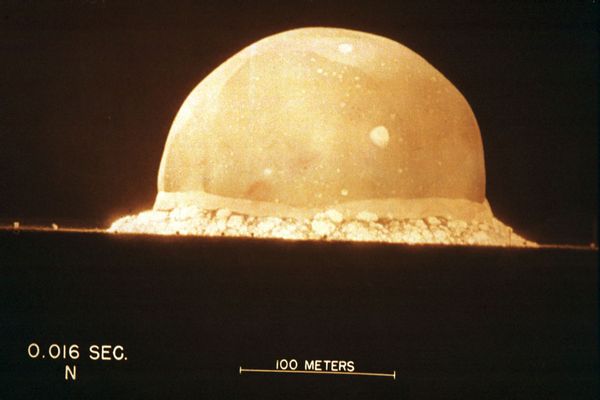
As the Russian invasion of Ukraine rages on, there is an ever-growing risk of a nuclear war or Chernobyl-like catastrophe breaking out. Similarly, as artificial intelligence technology (AI) grows more sophisticated, critics warn that it could lead to a nuclear mishap akin to the plot of the "Terminator" film series. In fact, the growing threat of nuclear calamity is such that director James Cameron, who made the first two "Terminator" movies, has already given his version of an "I told you so." Fellow movie director Christopher Nolan has done Cameron one better: He made a film about J. Robert Oppenheimer (in theaters now and titled, simply, "Oppenheimer"), the brilliant scientist widely regarded as the father of nuclear weapons.
Oppenheimer's story is relevant on its own merits simply because of the man's most famous invention, which changed history. His story is all the more important, though, because Oppenheimer spent his remaining years opposing the militarization of the very weapons he invented. In the process, he destroyed himself.
Early in the immense three-hour running time of "Oppenheimer," there is a quiet little moment that captures the essence of this epic movie about the invention of nuclear weapons. Theoretical physicist J. Robert Oppenheimer (Cillian Murphy) is discussing physics with psychiatrist and Communist reporter Jean Tatlock (Florence Pugh), who notes that Marxists and physicists alike seek knowledge of the laws that govern the universe. They pursue economic laws for moral and political ends in the former case, and immutable scientific laws to acquire knowledge in the latter.
As Oppenheimer and Tatlock spar and flirt, figurative sparks fly that are no less real than the literal ones we see as Oppenheimer leads a team that develops the world's first atomic bombs. It is a fitting metaphor for the movie as a whole: "Oppenheimer" unpacks the delicate balance between science and ideology, between wonderful ideas and their oft-devastating real-world consequences.
For such an ambitious endeavor to work, however, scientific and historical accuracy are key. Fortunately for fans of both, "Oppenheimer" delivers in telling the truth about the story of the Manhattan Project, at least as much as can be expected of a Hollywood blockbuster. To learn the reality about the man and the science behind "Oppenheimer," Salon spoke with experts on both.
The first important detail that the film gets right is that Oppenheimer, for all of his undeniable brilliance as a theoretician, is ultimately best remembered for practical achievements rather than intellectual ones.

"If Oppenheimer hadn't become scientific director of the Manhattan Project, he would possibly be remembered as someone who contributed towards getting the United States more 'on the map' as a place to get a theoretical physics education," Alex Wellerstein, science historian at the Stevens Institute of Technology and expert on the history of nuclear weapons, told Salon by email. "He did not spend enough effort on his other scientific contributions to really develop them into their full forms — others did, and some of them became pretty important, but he never seemed interested in that."
Instead, Oppenheimer's chief legacy is as "a key leader in the early nuclear age," particularly in developing the world's first atomic bombs. Later on, as the movie also accurately depicts, Oppenheimer's lifelong left-wing ideals caught up with him, compelling him to make peace with his conscience over creating a weapon that could destroy mankind. They also caught up with him in a more threatening sense, as Oppenheimer's past ties with Communists puts him in the government's cross-hairs during the Red Scare.
"When his security clearance was stripped from him in the 1950s, he became a very different sort of symbol about the relationship between security and science in the Cold War," Wellerstein pointed out, touching on another theme, martyrdom, also broached in the movie. "His contribution to history is a pretty complex one. It is hard to exactly define his 'scientific' contributions — it is not so much about any particular discoveries or scientific insights he had (again, he was considered quite brilliant, but not focused enough), so much as it is about his role in the changing context of how science was done in this country."
Author and journalist Jennet Conant, who has written seven books about World War II, including "109 East Palace: Robert Oppenheimer and the Secret City of Los Alamos," elaborated on this point. Conant wrote to Salon that Oppenheimer's chief legacy was in "sounding the alarm about the danger of a nuclear arms race and dedicating himself, at great personal and professional cost, to trying to implement international control of the terrifying destructive power he had helped to unleash."
Echoing a remark by Nolan, who observed that scientists in the 2020s are warning about AI much as they warned about nuclear weapons in the 1950s, Conant added that Oppenheimer "imposed this great moral obligation on himself to teach the world about the economics of destruction and it was a great lesson to scientists that they must have a voice in the treatment of their inventions."
Yet even though Oppenheimer tried to warn the world that it could not allow nuclear weapons to be used to fight wars, even as a remote possibility, Conant ruefully noted that the threat of nuclear war is "greater now than at any time since the hair-trigger era that followed the Soviet's first detonation of an atomic bomb in 1949."
"In addition to the terrible hazard posed by the escalating power, speed and accuracy of the nuclear weaponry of the U.S. and Russia, China is assembling an ever-greater arsenal and of the other six countries with nuclear capability — Britain, France, Israel, India, Pakistan, and North Korea — not all have judicious and trustworthy leaders," Conant explained. "The proliferation of portable nuclear weapons, so-called 'suitcase bombs' and tactical nuclear weapons with smaller yields that are compact enough to be carried in a backpack, present a new kind of threat in the war in Ukraine, where it is feared Putin might deploy them to force a settlement."
While all of this talk of war is sobering, it would be a mistake to assume that "Oppenheimer" is entirely dour. Quite to the contrary, the film reaches moments of ecstatic joy when it is allowed to slough off politics like a snake shedding unwanted dead skin, and instead focus on pure science. There are scenes in "Oppenheimer" that could be edited out and used in high school science classes for instruction: Explaining how all of the universe is composed of atoms, how every atom has a nucleus in its center and how atomic weapons release massive amounts of energy by destroying those nuclei. Nuclear weapons can break apart those nuclei or smash them together, using nuclear fission and nuclear fusion, and there is an eerie, hypnotic parallel to life's human-caused drama as Oppenheimer's physics insights flash across the screen in the form of sparks and explosives.
Even while celebrating the intrinsic love of knowledge that comes with pure scientific exploration, however, "Oppenheimer" includes ugly and necessary reminders of their real-world consequences. Take how a simple scientific theory — the possibility that the chain reaction wrought when humans start smash nuclei against each other never stops, igniting the atmosphere and destroying all life on Earth — winds up becoming a plot point. Indeed, "plot point" may be the wrong phrase; that simple scientific concept is practically a full-blooded antagonist, an idea breathing down the characters' necks as ominously as if it was an actual slimy, scaly, malevolent movie monster.
That specific threat has since been disproven, but many other hazards related to nuclear's destructive potential remain. Eliana Johns, a Research Associate with the Nuclear Information Project at the Federation of American Scientists (an organization that Oppenheimer was intimately involved with in real life), told Salon by email that "while it has only recently become a common topic since the end of the Cold War, the threat of nuclear weapons has remained ever since the Trinity test and the subsequent bombings of Hiroshima and Nagasaki in 1945." Yet unlike the 1940s, today "the warheads and delivery systems available in modern nuclear arsenals are exponentially more powerful," as well as more accurate, destructive and widespread.
"The legitimate threat of nuclear weapons is greater now since the end of the Cold War, but there is also a misconception that nuclear weapons don't cause any harm unless used against an enemy," Johns added. "In reality, communities around the world have been negatively impacted by the building, testing and use of nuclear weapons since their conception." This includes consequences that ensued as a direct result of the Manhattan Project.

Did Oppenheimer know about all of these things? He definitely knew about some of the impact that his testing would cause (the movie alluded, among other things, to his expressed wish to return the Los Alamos National Laboratory to Native American communities), but it is hard to say for sure whether he understood all of the details of what was happening so he could build his bombs. Some long-term consequences would have obviously been inconceivable for him.
Even if he did not know certain things for sure, though, it is difficult to believe that a man as savvy and well-educated as Oppenheimer didn't at least strongly suspect that marginalized communities were suffering in countless ways while he busily went about proving his genius. The man who spent his last years denouncing the hubris of scientists was, without question, a scientist who readily flew too close to the Sun himself.
"He is a very hard person to 'read' historically, and every historian has their own 'Oppenheimer' in a way," Wellerstein noted. "He was not some inadvertent dove who got accidentally caught up in the matter of making and using atomic bombs. He was a very active participant, despite having a very nuanced view of the use of the weapons and their long-term potential. He does not easily fit into the modern categories that people often want to impose on the issue of nuclear weapons."
Perhaps it all goes back to that scene of dialogue between Oppenheimer and Tatlock. There are two sets of laws that govern the universe, the solid scientific ones studied by Oppenheimer and the nebulous moral ones discerned by Tatlock and others like her. In an ideal world, those who pursue scientific truth and those who seek moral truth would always work together in harmony. Unfortunately, just like the atoms used in nuclear weapons, scientific and moral truths in our real world often crash against each other, all too often with explosive results.







